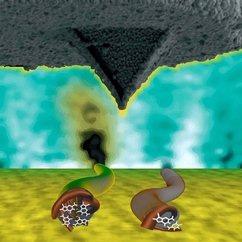Attempts to resolve the energy-level structure of single DNA molecules by scanning tunnelling spectroscopy span over the past two decades, owing to the unique ability of this technique to probe the local density of states of objects deposited on a surface. Nevertheless, success was hindered by extreme technical difficulties in stable deposition and reproducibility. Here, by using scanning tunnelling spectroscopy at cryogenic temperature, we disclose the energy spectrum of poly(G)–poly(C) DNA molecules deposited on gold. The tunnelling current–voltage (I–V) characteristics and their derivative (dI/dV–V) curves at 78 K exhibit a clear gap and a peak structure around the gap. Limited fluctuations in the I–Vcurves are observed and statistically characterized. By means of ab initiodensity functional theory calculations, the character of the observed peaks is generally assigned to groups of orbitals originating from the different molecular components, namely the nucleobases, the backbone and the counterions.

Attempts to resolve the energy-level structure of single DNA molecules by scanning tunnelling spectroscopy span over the past two decades, owing to the unique ability of this technique to probe the local density of states of objects deposited on a surface. Nevertheless, success was hindered by extreme technical difficulties in stable deposition and reproducibility. Here, by using scanning tunnelling spectroscopy at cryogenic temperature, we disclose the energy spectrum of poly(G)–poly(C) DNA molecules deposited on gold. The tunnelling current–voltage (I–V) characteristics and their derivative (dI/dV–V) curves at 78 K exhibit a clear gap and a peak structure around the gap. Limited fluctuations in the I–Vcurves are observed and statistically characterized. By means of ab initiodensity functional theory calculations, the character of the observed peaks is generally assigned to groups of orbitals originating from the different molecular components, namely the nucleobases, the backbone and the counterions.
